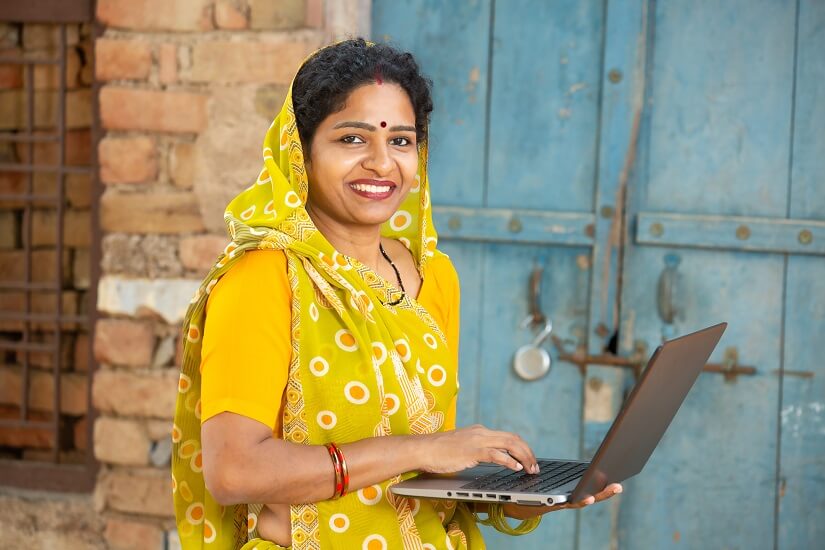Befriending Technology to Improve Lives at Grassroots

Finding praise for technological advancement is not difficult—from the front cover of newspapers to every other webpage featuring the word ‘technology,’ it is pervasive and omnipresent. As a people, we have staked our collective future happiness on the promise that technological progress will somehow safeguard us from the peril of our own making.
But have you wondered how technology actually affects the last mile? What exactly is the change that access to technology brings for communities who need help?
Of all the policies and interventions created by governing bodies to empower rural economies, the Deendayal Antyodaya Yojana- National Rural Livelihood Mission (DAY-NRLM) is worthy of note because of its aim to include technological interventions for easy access to banking facilities.
Banking facilities are not as easily accessible everywhere as you may think. Rural economies continue to rely on informal sources of credit, trapping people in a vicious cycle of debt due to the unregulated interest rates forced onto them in need of credit.
But with initiatives that are part of DAY-NRLM, such as JEEViKA (another name for the Bihar Rural Livelihoods Promotion Society (BRLPS)), financial literacy and access to formal banking services have begun to reach poor rural households, enabling them to improve their quality of life.
How is technology part of this initiative, and how is it helping last-mile communities?
Rubi Kumari’s success story is a testament to just how impactful technology can become when put into the hands of the people who need it the most.
Rubi lives in the Pawna village of Bhojpur district in Bihar. A 25-year-old single parent, working as a tailor and a beautician while also operating as a Banking Correspondent Sakhi (BC Sakhi) in her area, she truly does it all. But no one can have it all without struggling for it.
The idea of independence depends entirely on the socio-economic context someone emerges from. For Ruby, it was the same. Her gender stood in the way of education, so she could only study till grade 10. Still undeterred by cultural challenges, Rubi enrolled in tailoring and beauty courses, allowing her to pursue her interests.

Soon after, she was married but decided to separate from her husband after the birth of her child to take life in a different direction. But such a decision can severely cost a woman living in a patriarchal society. Pressure from family members kept her on her toes, and because of this, Rubi decided to use her vocation as a tailor and beautician to create a source of income.
Education opens doors for people, but for women, it creates alternative life paths capable of changing the face of the world!
What she couldn’t do as a teenage girl, Rubi achieved as a young woman—she funded her graduation from her savings. She expanded her business while mothering her son and providing for his education. But she knew she had more to achieve, so when the BC Sakhi position opened up in her area, Rubi didn’t waste any time applying for it.
Who is a BC Sakhi?
A Bank Correspondent Sakhi, also called a BC Sakhi, is a Self-Help Group (SHG) member that helps members with day-to-day banking services like documentation, loan facilitation, recovery, etc.
Rubi became interested in the position precisely due to the skills it required her to develop. As an avid learner, she developed the skills quickly during her JEEViKA training sessions. Before she could employ her newly acquired knowledge to operate her customer service point (CSP), Rubi worked at a local bank and learned the ins and outs of the system.
She knew it would help her become a familiar face for people in her region so that when the time came for Ruby’s CSP to be set up, people wouldn’t be as hesitant to approach and acquire the services she offered.
But how does a person with little access to digital technology run a bank branch?
That is where JEEViKA’s training sessions come into play. Rubi learned basic computer skills and was given a laptop and a printer to conduct banking transactions. With this support, Rubi was motivated to learn banking services such as bank account opening, transactions, and other services like enrolling for their financial products such as insurance and pension.

This is how technology and its advantages reach the people who need its access the most for their life to improve in meaningful ways.
With her newly acquired knowledge of digital technologies, Ruby helped customers overcome the fear of transacting their hard-earned money outside bank branches by promoting her Community Service Provider (CSP) outlet and attending SHG and Village Organization meetings to spread awareness about the initiative. She even offered doorstep services to older women and female members among conservative families who were not allowed to a bank branch or visit her outlet.
Now, her CSP attracts many female customers, who have begun to trust Rubi with their income. By June 2019, Rubi reported conducting transactions of INR 71.19 lakhs for her community. Through all her ventures as an entrepreneur and a BC Sakhi, Rubi has begun earning close to INR 25,000 monthly. She wants to take it up to a more significant amount by acquiring new customers and encouraging more transactions within her community.
When given the right resources, people like Rubi can demonstrate the transformative power of technology, making the case for giving access to such transformative tools to the very people who need them the most.
References:
Aishwarya Bhatia, Sambodhi
